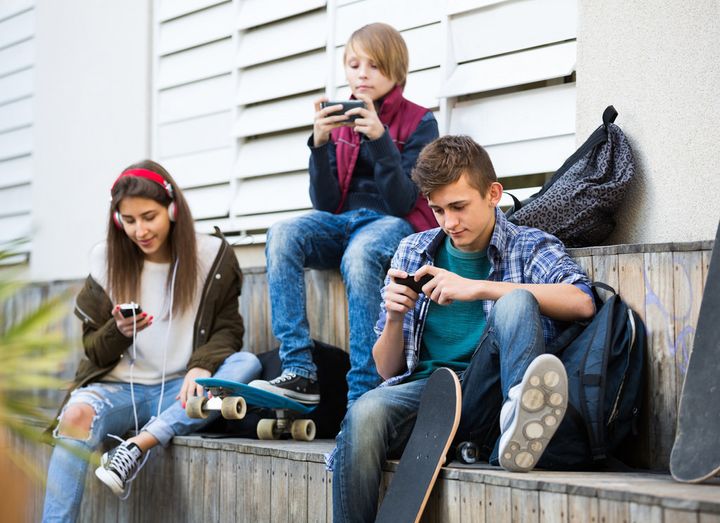
As a parent of a child who will be stepping into teenage in a few months, I have a lot to learn. It has been a few decades since I had been a teen myself and memories of the age are more nostalgic than factual, nostalgia being defined as a seed of reality surrounded by fluff of imagination and wishful thinking. Besides, there was no computer to dreamily stare into while the rest of the world was running around like a head-cut chicken, as I see my ward do often enough these days. Chances are that she is reading about the new “ship” (there, I’ve learnt a new word already) or watching a K-Pop parody on YouTube. I am happy if she is doing the above, and not chatting with random strangers posing as young girls. It is important for me (as for any parent of a teen) to be aware of what teens in general are doing online these days, for I know that peer pressure and peer influence will rule my child’s life for the next few years.
- Lakshmi, a Mobicip blogger and co-author of this article.
Business Insider recently put together a survey on what American teenagers in 2016 like and dislike. Sixty teenagers were polled from across the country – although 60 seems like a very small number to represent a 41 million population of teens in the country, not to mention the 1.8 billion youth all around the world, the fact that the sixty are spread across the nation and are from different socioeconomic classes, grades, and ages could offer useful pointers.
The first interesting observation was that children get their first smartphone at the average age of 11. It seems fairly accurate since my own child got her iPod (in lieu of a smartphone) for her 12th birthday and we pride ourselves on being an averagely conservative family. They spend 11 hours watching some screen or the other, which I have no problems believing. Given that a lot of school work and hobbies (my child writes stories and poems in her blog, for example) involve the computer these days, it becomes hard to find the ratio of time spent usefully versus time spent staring aimlessly at moving images. My child pegs it at 80:20, and I argue that it cannot be anything more than 1:99.
What teenagers do online depends a lot on their peer group. My child, who has loved to write ever since she could hold a pencil, has been blogging (under a pseudonym, the parents are paranoid about safety) since she was six years old. It is interesting that many of her friends blog now, and I can only attribute it to peer influence. My child and her friends fall into the habit of chatting online mostly using their parents’ email ids (most of them are just about turning 13), but the families are conservative enough to set time limits for online chatting. True enough, the children stretch limits and chat clandestinely (switching windows when the parents are around, is the most clichéd and predictable action in the world), but for this particular group, listening to music, watching videos of popular and funny YouTubers and reading fan-fiction are predominant non-productive activities on the net.
Another survey called Piper Jaffray’s teen survey, reported by BI Intelligence, finds Instagram to be the most widely used chatting software among the youth. Teenagers, especially girls, use Instagrams in highly creative ways – while snapchat allows posting of photos as is, programs within apps such as VSCO within Instagram allows them to edit photos and post creative content. Driven by the need for “likes”, teenagers tend to use Instagram a lot more than other social networking software. Another less-known trend among teenagers is having a second Instagram account, called the “finsta” (“fake insta”), to share specific material among select audience. While it seems like a mature move for the teen to differentiate between material to be shared among friends and those to be shared to the general public, the use of Instagram and finsta can be addicting, and the addiction can grow out of the obsession for getting more followers and likes. Research has found a link between the number of strangers that Instagram users follow and the possibility that they experience depressive symptoms, such as fearfulness, loneliness or fatigue.
Instagram is followed by Twitter and Snapchat in terms of popularity among the teens. These programs, as with most social media applications, require users to be at least 13 years of age. It is interesting that twitter outperforms Facebook among teens. It seems that most teens find Facebook restrictive because of the presence of family members in it. Facebook, however, continues to be used as a platform to chat with friends.

Instagram, FB, Twitter, Tumblr and the likes are social network sites that parents, being the digital immigrants that they are, know of. There are apps/sites that are prevalent among teens, that adults are largely unaware of. “After School”, according to the website, is “a private social network that allows American high school students to share and connect with fellow students at their same school”. Although the app website claims it to have “zero tolerance” to cyber bullying, After School has allegedly become a vehicle for bullying and unsavory activities, under a cloak of secrecy. According to the Washington Post, millions of teens are using it to post their “deepest anxieties, secret crushes, vulgar assessments of their classmates, and even violent threats”.
There are apps that masquerade as harmless (or even useful) applications, but are really time bombs in action. While an app called “Audio Manager” appears to the nubile adult as a harmless application to manage, store and listen to music, it is, in reality, an app that can hide other apps that the teenager does not want the adult to see. “Calculator%” does not make the kid a math whiz but is essentially “Audio Manager” with a different name; it made news recently because teens used this app to hide a huge sexting ring from parents and school officials.
There are apps that are not so sneaky, but are used by teenagers wanting to hide stuff from the eyes of parents. “Vaulty” for instance, can be used to “hide” photos and BurnNote erases messages after a period of time. While the teenagers are entitled to their privacy, it becomes dicey if they want to deliberately “hide” things from parental eyes. Apps like Omegle, which allows users to chat with strangers, rightfully strike panic into the heart of every parent. Even in instant messaging, there are some apps that have dubious reputation – kik, for instance, by the absence of parental control and the bad rap it has garnered over the years, appears to be a site for sexual predators to prey on teenagers. Apps such as Whisper and YikYak are geography based, and the location of the participant can be known to strangers. The presence of such apps in the teenager’s device must be dealt with carefully by the parent.
The digital age is unusual in that the teenager was born into it as against the parent who was likely dragged into kicking and screaming. The learning process must therefore be cooperative. Transparency and trust between teenagers and their parents are essential to make the digital youthhood enjoyable and beneficial to all concerned.
Writing credit: Co-authored by Lakshmi, a Mobicip blogger and mom who researches the play of technology on parenting and child behaviour.
Mobicip is the creator of the most powerful and extensive internet safety software for tablets, smartphones and computers in households today. Learn more at www.mobicip.com.
